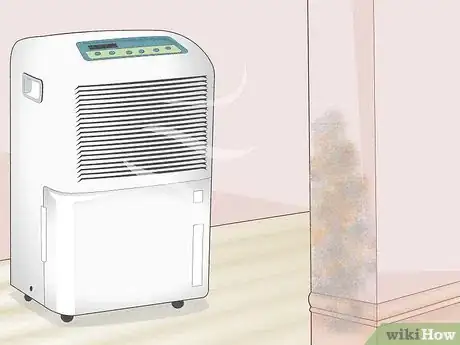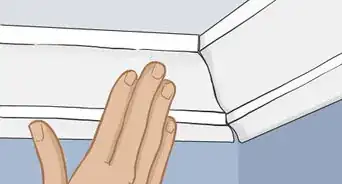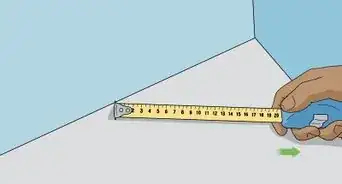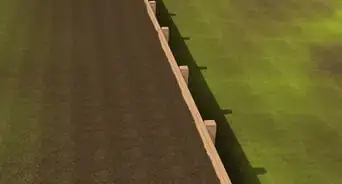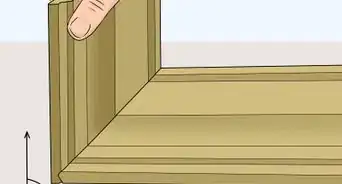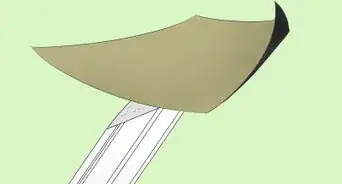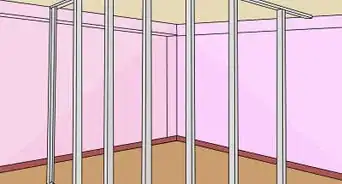This article was co-authored by Ryaan Tuttle. Ryaan Tuttle is a Home Improvement Specialist and the CEO of Best Handyman, Inc. in Boston, Massachusetts. With over 17 years of experience, he specializes in building home service businesses, focusing on creating scalable and efficient brands. With the help of his global team, the companies have achieved over 10+ million in sales and received recognition through magazine features, and enjoy partnerships with wikiHow and Jobber field service software. Boston Magazine and LocalBest.com have named Best Handyman Boston the Best Handyman in Boston. Ryaan holds Construction Supervisor and Home Improvement Contractor Licenses.
There are 8 references cited in this article, which can be found at the bottom of the page.
This article has been viewed 121,095 times.
Floods, pipe leaks, and similar events can create a ton of water buildup inside your walls. When left unattended, this moisture will damage your building's structural integrity and lead to the formation of dangerous molds and fungi. Thankfully, there are a number of different ways you can dry out your walls and rectify the problem.
Steps
Containing the Problem
-
1Locate and fix any water leaks near your wall. If a broken water pipe, faucet, or similar fixture led to the moisture damage in your wall, you'll need to fix the busted object before you can dry everything out. To deal with minor pipe damage, try resealing the pipe with epoxy putty. For major pipe damage and broken water appliances, you may need to strip out and replace the fixture entirely.[1]
- For safety, hire a professional pipe repair service to deal with leaks located inside your wall.
- If you live in a housing complex, the water damage may have come from one of your neighbors.
-
2Drain out any standing water located in the wall. Depending on the severity of the water damage, your wall may contain a significant amount of standing water. To check, drill a small hole into the wall about 2 in (5.1 cm) off the ground and see if water comes out. If any does, drill small holes along the wall to drain the water.[2]
- Keep your holes about 2 in (5.1 cm) off the ground and space them so that they are between 16 and 24 in (41 and 61 cm) apart.
- Before creating your holes, locate the studs inside your wall. For the best possible results, drill in the area between these spots.
Advertisement -
3Remove extremely damaged areas of the wall to prevent long-term issues.[3] You might need to strip out and replace some parts of your wall following instances of extreme water damage. If you fail to do so, the affected areas may develop dangerous forms of mildew or mold and, in some cases, will put the integrity and stability of the entire wall at risk. Contact a certified wall repair service if you spot:[4]
- Black patches or streaks on drywall.
- Warped spots on wood walls.
- Cracks, blisters, or discolored areas on wood walls or drywall.
- Rusted or warped spots on metal stud walls.
- Chipped, bowed, or dissolved spots on brick or stone walls.
Choosing a Drying Technique
-
1Use room fans to dry out small damp spots. If the moisture only affected a small area of the wall, you may be able to dry it out using standard oscillating fans. To do so, place 1 or more fans in front of each damp spot and turn the fans to their highest setting. This will help clear out moist air while actively drying the damp spots.[5]
- Turn on your fan's oscillation function if you need to target multiple areas of the wall with 1 fan.
-
2Purchase a dehumidifier to deal with large patches of moisture. Buy a heavy-duty dehumidifier that can process at least 50 imp pt (28,000 ml) of water each day. Using the manufacturer's included instructions, hook the device up in the same room as your damp wall. Make sure to close the room's doors and windows, then run the device.[6]
- Heavy-duty dehumidifiers start at around $230 for a 50 pint unit.
- Look for dehumidifiers at home improvement and home appliance stores.
-
3Use desiccants to absorb moisture in closed areas. If you're trying to dry out a small, enclosed area like a closet, normal drying techniques may not work. Instead, try placing moisture absorbent materials, or desiccants, near the wall to suck out some of the excess water vapor. Common desiccants available at most hardware and grocery stores include:[7]
- Chemical dehumidifier packs
- Clay cat litter
- Calcium chloride pellets
-
4Hire a contractor to deal with major water damage. If you can't dry out the wall yourself, search online or in your local yellow pages for a contractor specializing in Dehumidifying or Water Damage Restoration. On average, it costs between $3.75 and $7.00 to clean up 1 sq ft (0.093 m2) of moisture damaged wall.[8]
- Avoid contractors who ask for payment in advance, especially if they live out of town, since there's a good chance they will try to overcharge or scam you.
Accelerating the Drying Process
-
1Turn on your house's A/C to reduce the humidity in the air. If the moisture in your wall is coming primarily from the humidity in the air, try turning on your house's central air-conditioning system. Warm air retains more moisture than cool air, so chilling your room will lower the humidity significantly and make it easier to dry out the wall.[9]
- If you don't have a central A/C system, try purchasing a portable or window unit.
-
2Open up your house to increase air circulation. To help replace your house's old, moist air with fresh, dry air, try opening up any doors and windows located near the moisture damaged area. This will increase air circulation around the damp wall, speeding up the drying process.[10]
- Do not open your windows and doors if you're using a dehumidifier.
- For the best results, use this method during the day while the sun is out.
- This method may not work if you live in an extremely humid area.
-
3Remove any wall coverings to increase your wall's ventilation. Wallpaper, wall fabric, and similar wall coverings will prevent air from reaching the wall itself, slowing down the drying process. In addition, soaked wall coverings can harbor dangerous mold and mildew, making them unsafe.[11]
- Along with standard wall coverings, remove any other objects placed on your wall such as posters and floating shelves.
-
4Open up wall mounted cabinets to help them dry faster. If your damp wall houses any cabinets or similar furniture items, open up their doors and slide out their drawers. Not only will this help the cabinet dry faster, but it will speed up the overall drying process by increasing air circulation in the area.[12]
Expert Q&A
-
QuestionHow can I dry behind my walls faster after removing the drywall and insulation?
 Ryaan TuttleRyaan Tuttle is a Home Improvement Specialist and the CEO of Best Handyman, Inc. in Boston, Massachusetts. With over 17 years of experience, he specializes in building home service businesses, focusing on creating scalable and efficient brands. With the help of his global team, the companies have achieved over 10+ million in sales and received recognition through magazine features, and enjoy partnerships with wikiHow and Jobber field service software. Boston Magazine and LocalBest.com have named Best Handyman Boston the Best Handyman in Boston. Ryaan holds Construction Supervisor and Home Improvement Contractor Licenses.
Ryaan TuttleRyaan Tuttle is a Home Improvement Specialist and the CEO of Best Handyman, Inc. in Boston, Massachusetts. With over 17 years of experience, he specializes in building home service businesses, focusing on creating scalable and efficient brands. With the help of his global team, the companies have achieved over 10+ million in sales and received recognition through magazine features, and enjoy partnerships with wikiHow and Jobber field service software. Boston Magazine and LocalBest.com have named Best Handyman Boston the Best Handyman in Boston. Ryaan holds Construction Supervisor and Home Improvement Contractor Licenses.
Home Improvement Specialist You can put some air purifiers or fans back there to help dry everything out.
You can put some air purifiers or fans back there to help dry everything out.
Warnings
- Depending on how damp your walls are, the drying process may take weeks or even months to complete.⧼thumbs_response⧽
References
- ↑ https://www.fema.gov/pdf/rebuild/recover/fema_mold_brochure_english.pdf
- ↑ https://realestate.usnews.com/real-estate/articles/how-to-dry-out-your-house-after-a-flood
- ↑ Ryaan Tuttle. Home Improvement Specialist. Expert Interview. 24 February 2021.
- ↑ https://www.epa.gov/sites/production/files/2014-08/documents/moisture-control.pdf
- ↑ http://www.achd.net/pr/pubs/pdf/dryout.pdf
- ↑ https://www.thisoldhouse.com/how-to/drying-out-wet-basement
- ↑ https://www.redcross.org/images/MEDIA_CustomProductCatalog/m4540081_repairingFloodedHome.pdf
- ↑ http://www.achd.net/pr/pubs/pdf/dryout.pdf
- ↑ http://www.nytimes.com/2006/07/09/realestate/09home.html
About This Article
To dry out small spots, place a fan in front of the damp area and turn it on high. For larger spots, install a heavy-duty dehumidifier in the room to suck the water vapor out. If you need to dry out a wall in an enclosed area, place moisture absorbent materials like dehumidifier packs near the damp spots. You can speed up the drying process by turning on your house’s AC, opening up doors and windows near the damp area, and removing any fixtures hanging from your wall. To learn how to fix water leaks and remove standing water from your walls, read on!





